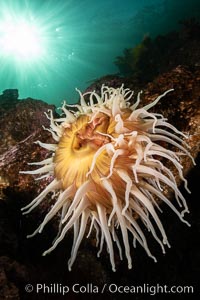
The Fish Eating Anemone Urticina piscivora, a large colorful anemone found on the rocky underwater reefs of Vancouver Island, British Columbia.
Species: Fish-eating anemone, Urticina piscivora
Location: British Columbia, Canada
Image ID: 35274
Species: Fish-eating anemone, Urticina piscivora
Location: British Columbia, Canada
Image ID: 35274
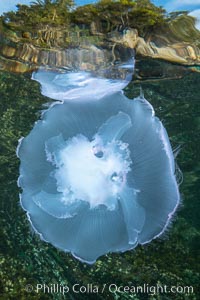
Moon jelly, Browning Pass, Vancouver Island, Canada.
Species: Moon jelly, Aurelia aurita
Location: British Columbia, Canada
Image ID: 35281
Species: Moon jelly, Aurelia aurita
Location: British Columbia, Canada
Image ID: 35281
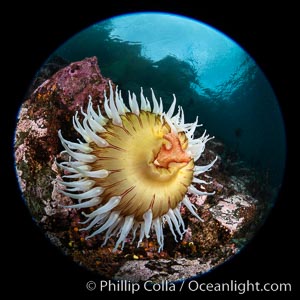
The Fish Eating Anemone Urticina piscivora, a large colorful anemone found on the rocky underwater reefs of Vancouver Island, British Columbia.
Species: Fish-eating anemone, Urticina piscivora
Location: British Columbia, Canada
Image ID: 35282
Species: Fish-eating anemone, Urticina piscivora
Location: British Columbia, Canada
Image ID: 35282
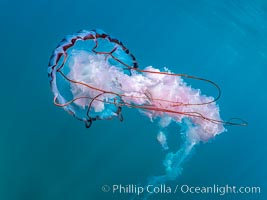
Purple-striped jellyfish, Coronado Islands, Mexico.
Location: Coronado Islands (Islas Coronado), Baja California, Mexico
Image ID: 37049
Location: Coronado Islands (Islas Coronado), Baja California, Mexico
Image ID: 37049
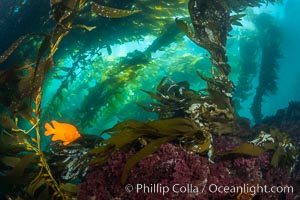
Garibaldi swims in the kelp forest, sunlight filters through towering giant kelp plants rising from the ocean bottom to the surface, underwater.
Species: Garibaldi, Hypsypops rubicundus
Location: San Clemente Island, California
Image ID: 37091
Species: Garibaldi, Hypsypops rubicundus
Location: San Clemente Island, California
Image ID: 37091
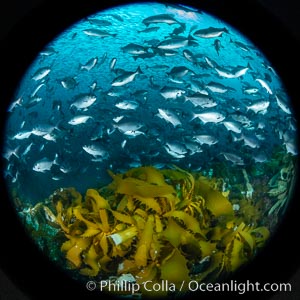
Huge mixed schools of fish on Farnsworth Banks, Catalina Island, California. A veritable fish storm of epic proportions centered on Farnsworth Banks was experienced by divers for a few weeks in 2021.
Species: Halfmoon perch, Medialuna californiensis
Location: Catalina Island, California
Image ID: 37244
Species: Halfmoon perch, Medialuna californiensis
Location: Catalina Island, California
Image ID: 37244
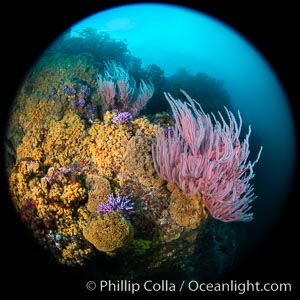
Red gorgonian Leptogorgia chilensis, purple hydrocoral Stylaster californicus, and yellow zoanthid anemone Epizoanthus giveni, at Farnsworth Banks, Catalina Island.
Species: Red gorgonian, Hydrocoral, Givens Zoanthid, Leptogorgia chilensis, Lophogorgia chilensis, Allopora californica, Stylaster californicus, Epizoanthus giveni
Location: Catalina Island, California
Image ID: 37251
Species: Red gorgonian, Hydrocoral, Givens Zoanthid, Leptogorgia chilensis, Lophogorgia chilensis, Allopora californica, Stylaster californicus, Epizoanthus giveni
Location: Catalina Island, California
Image ID: 37251
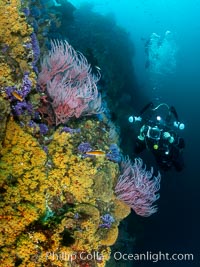
Red gorgonian Leptogorgia chilensis, purple hydrocoral Stylaster californicus, and yellow zoanthid anemone Epizoanthus giveni, at Farnsworth Banks, Catalina Island.
Species: Red gorgonian, Hydrocoral, Givens Zoanthid, Leptogorgia chilensis, Lophogorgia chilensis, Allopora californica, Stylaster californicus, Epizoanthus giveni
Location: Catalina Island, California
Image ID: 37271
Species: Red gorgonian, Hydrocoral, Givens Zoanthid, Leptogorgia chilensis, Lophogorgia chilensis, Allopora californica, Stylaster californicus, Epizoanthus giveni
Location: Catalina Island, California
Image ID: 37271
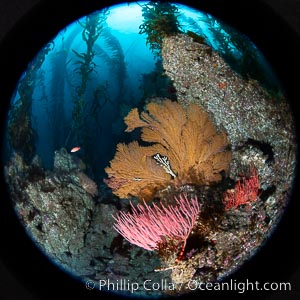
Red gorgonian and California golden gorgonian on underwater rocky reef, San Clemente Island. The golden gorgonian is a filter-feeding temperate colonial species that lives on the rocky bottom at depths between 50 to 200 feet deep. Each individual polyp is a distinct animal, together they secrete calcium that forms the structure of the colony. Gorgonians are oriented at right angles to prevailing water currents to capture plankton drifting by.
Species: Red gorgonian, California golden gorgonian, Leptogorgia chilensis, Lophogorgia chilensis, Muricea californica
Location: San Clemente Island, California
Image ID: 38499
Species: Red gorgonian, California golden gorgonian, Leptogorgia chilensis, Lophogorgia chilensis, Muricea californica
Location: San Clemente Island, California
Image ID: 38499
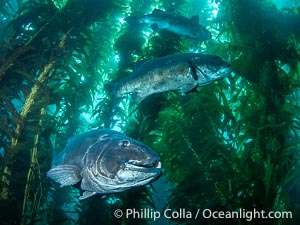
Three Giant Black Sea Bass in a Courtship Posture, Hovering One Above the Other in Kelp at Catalina Island. In summer months, black seabass gather in kelp forests in California to form mating aggregations. Courtship behaviors include circling of pairs of giant sea bass, production of booming sounds by presumed males, and nudging of females by males in what is though to be an effort to encourage spawning.
Species: Giant black sea bass, Stereolepis gigas
Location: Catalina Island, California
Image ID: 39434
Species: Giant black sea bass, Stereolepis gigas
Location: Catalina Island, California
Image ID: 39434
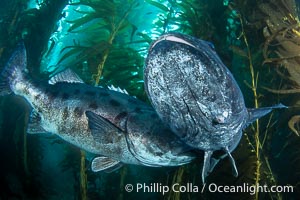
A male giant sea bass nudges a female giant sea bass to encourage spawning as they swim in a tight circle. This courting pair of giant sea bass is deep in the kelp forest at Catalina Island. In summer months, giant sea bass gather in kelp forests in California to form courtship and mating aggregations, eventually leading to spawning.
Species: Giant black sea bass, Stereolepis gigas
Location: Catalina Island, California
Image ID: 39435
Species: Giant black sea bass, Stereolepis gigas
Location: Catalina Island, California
Image ID: 39435
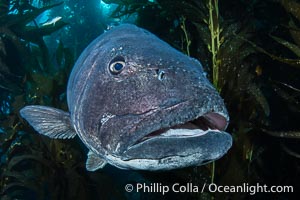
Closeup Portrait of the Face of a Giant Black Sea Bass, showing parasitic sea lice. These parasites find their nutrition from the skin and blood of the host giant sea bass. Smaller fishes such as senoritas and wrasses will commonly clean the sea lice off the giant sea bass.
Species: Giant black sea bass, Stereolepis gigas
Location: Catalina Island, California
Image ID: 39436
Species: Giant black sea bass, Stereolepis gigas
Location: Catalina Island, California
Image ID: 39436
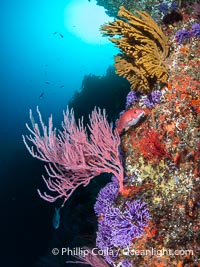
Red gorgonian Leptogorgia chilensis, purple hydrocoral Stylaster californicus, and yellow zoanthid anemone Epizoanthus giveni, at Farnsworth Banks, Catalina Island.
Location: Catalina Island, California
Image ID: 39540
Location: Catalina Island, California
Image ID: 39540
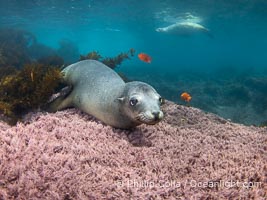
Female California sea lion laying on pink marine algae, Coronado Islands, Mexico. Another female rests at the surface in the background, and two orange garibaldi fish swim around over the reef.
Species: California sea lion, Zalophus californianus
Location: Coronado Islands (Islas Coronado), Baja California, Mexico
Image ID: 39767
Species: California sea lion, Zalophus californianus
Location: Coronado Islands (Islas Coronado), Baja California, Mexico
Image ID: 39767
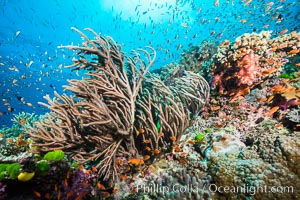
Branching whip coral (Ellisella sp) captures passing planktonic food in ocean currents, Fiji.
Species: Anthias, Branching whip coral, Ellisella, Pseudanthias
Location: Fiji
Image ID: 31324
Species: Anthias, Branching whip coral, Ellisella, Pseudanthias
Location: Fiji
Image ID: 31324
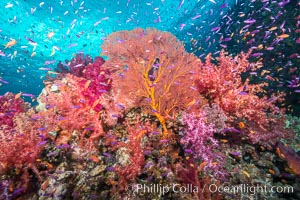
Beautiful tropical reef in Fiji. The reef is covered with dendronephthya soft corals and sea fan gorgonians, with schooling Anthias fishes swimming against a strong current.
Species: Anthias, Dendronephthya soft coral, Gorgonian, Dendronephthya, Gorgonacea, Pseudanthias
Location: Gau Island, Lomaiviti Archipelago, Fiji
Image ID: 31328
Species: Anthias, Dendronephthya soft coral, Gorgonian, Dendronephthya, Gorgonacea, Pseudanthias
Location: Gau Island, Lomaiviti Archipelago, Fiji
Image ID: 31328
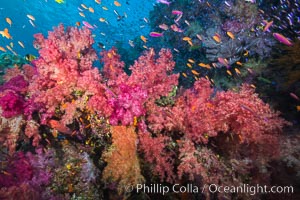
Dendronephthya soft corals and schooling Anthias fishes, feeding on plankton in strong ocean currents over a pristine coral reef. Fiji is known as the soft coral capitlal of the world.
Species: Anthias, Dendronephthya soft coral, Dendronephthya, Pseudanthias
Location: Namena Marine Reserve, Namena Island, Fiji
Image ID: 31338
Species: Anthias, Dendronephthya soft coral, Dendronephthya, Pseudanthias
Location: Namena Marine Reserve, Namena Island, Fiji
Image ID: 31338
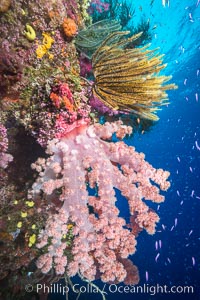
Pristine South Pacific tropical coral reef, with vibrant colorful dendronephthya soft corals, crinoids and schooling Anthias fishes, pulsing with life in a strong current. Fiji is known as the soft coral capitlal of the world.
Species: Anthias, Crinoid feather star, Dendronephthya soft coral, Crinoidea, Dendronephthya, Pseudanthias
Location: Namena Marine Reserve, Namena Island, Fiji
Image ID: 31339
Species: Anthias, Crinoid feather star, Dendronephthya soft coral, Crinoidea, Dendronephthya, Pseudanthias
Location: Namena Marine Reserve, Namena Island, Fiji
Image ID: 31339
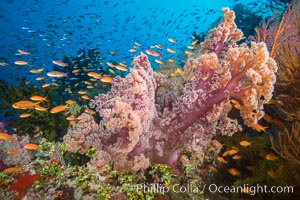
Dendronephthya soft corals and schooling Anthias fishes, feeding on plankton in strong ocean currents over a pristine coral reef. Fiji is known as the soft coral capitlal of the world.
Species: Anthias, Dendronephthya soft coral, Dendronephthya, Pseudanthias
Location: Fiji
Image ID: 31340
Species: Anthias, Dendronephthya soft coral, Dendronephthya, Pseudanthias
Location: Fiji
Image ID: 31340
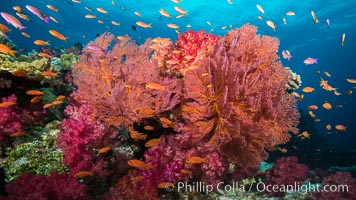
Beautiful South Pacific coral reef, with gorgonian sea fans, schooling anthias fish and colorful dendronephthya soft corals, Fiji.
Species: Anthias, Dendronephthya soft coral, Gorgonian, Dendronephthya, Gorgonacea, Pseudanthias
Location: Fiji
Image ID: 31341
Species: Anthias, Dendronephthya soft coral, Gorgonian, Dendronephthya, Gorgonacea, Pseudanthias
Location: Fiji
Image ID: 31341
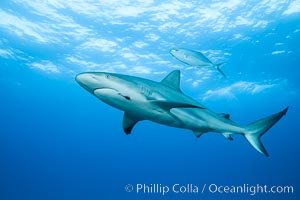
Caribbean reef shark with fishing hook.
Species: Caribbean reef shark, Carcharhinus perezi
Location: Bahamas
Image ID: 31982
Species: Caribbean reef shark, Carcharhinus perezi
Location: Bahamas
Image ID: 31982
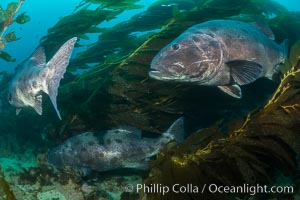
Three giant black sea bass, gathering in a mating/courtship aggregation amid kelp forest at Catalina Island. In summer months, black seabass gather in kelp forests in California to form mating aggregations. Courtship behaviors include circling of pairs of giant sea bass, production of booming sounds by presumed males, and nudging of females by males in what is though to be an effort to encourage spawning.
Species: Giant black sea bass, Stereolepis gigas
Location: Catalina Island, California
Image ID: 33355
Species: Giant black sea bass, Stereolepis gigas
Location: Catalina Island, California
Image ID: 33355
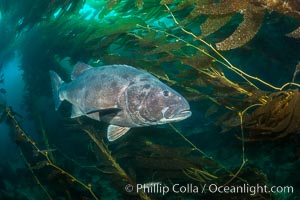
Giant Black Sea Bass with Unique Pattern of Black Spots at Catalina Island. The giant sea bass is an endangered species reaching up to 8' in length and 500 lbs, amid giant kelp forest.
Species: Giant black sea bass, Stereolepis gigas
Location: Catalina Island, California
Image ID: 33356
Species: Giant black sea bass, Stereolepis gigas
Location: Catalina Island, California
Image ID: 33356
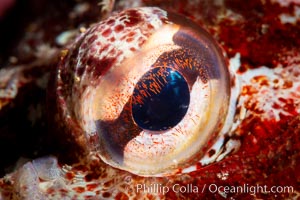
Red Irish Lord eye detail, Browning Pass, British Columbia.
Species: Red irish lord, Hemilepidotus hemilepidotus
Location: British Columbia, Canada
Image ID: 35269
Species: Red irish lord, Hemilepidotus hemilepidotus
Location: British Columbia, Canada
Image ID: 35269
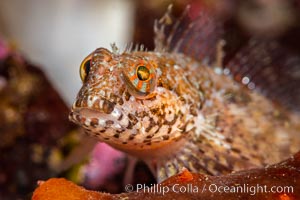
Tiny fish, unidentified, Browning Pass, Vancouver Island.
Location: British Columbia, Canada
Image ID: 35270
Location: British Columbia, Canada
Image ID: 35270
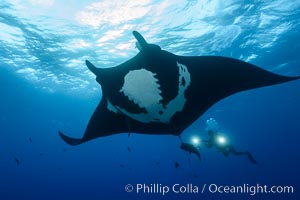
Giant Manta Ray at Socorro Island, Revillagigedos, Mexico.
Species: Giant manta ray, Manta birostris
Location: Socorro Island (Islas Revillagigedos), Baja California, Mexico
Image ID: 33291
Species: Giant manta ray, Manta birostris
Location: Socorro Island (Islas Revillagigedos), Baja California, Mexico
Image ID: 33291
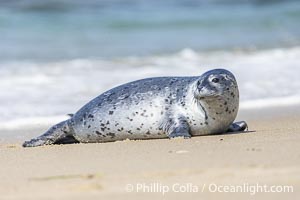
Pacific Harbor Seal Pup About Three Weeks Old, hauled out on a white sand beach along the coast of San Diego. This young seal will be weaned off its mothers milk and care when it is about four to six weeks old, and before that time it must learn how to forage for food on its own, a very difficult time for a young seal.
Species: Pacific harbor seal, Phoca vitulina richardsi
Location: La Jolla, California
Image ID: 39068
Species: Pacific harbor seal, Phoca vitulina richardsi
Location: La Jolla, California
Image ID: 39068

Pacific Harbor Seal Pup About Three Weeks Old, hauled out on a white sand beach along the coast of San Diego. This young seal will be weaned off its mothers milk and care when it is about four to six weeks old, and before that time it must learn how to forage for food on its own, a very difficult time for a young seal.
Species: Pacific harbor seal, Phoca vitulina richardsi
Location: La Jolla, California
Image ID: 39069
Species: Pacific harbor seal, Phoca vitulina richardsi
Location: La Jolla, California
Image ID: 39069

A newborn harbor seal pup, only a few minutes old, is nuzzled by its mother shortly after birth. Blood is still on the tiny pups fur coat. The pair will nuzzle frequently to solidify the bond they must maintain as the pup is nearly helpless. In just four to six weeks the pup will be weaned off its mothers milk and must forage for its own food.
Species: Pacific harbor seal, Phoca vitulina richardsi
Location: La Jolla, California
Image ID: 39073
Species: Pacific harbor seal, Phoca vitulina richardsi
Location: La Jolla, California
Image ID: 39073

A newborn harbor seal pup in La Jolla, only a few minutes old, is nuzzled by its mother shortly after birth. Blood is still on the tiny pups fur coat. The pair will nuzzle frequently to solidify the bond they must maintain as the pup is nearly helpless. In just four to six weeks the pup will be weaned off its mothers milk and must forage for its own food.
Species: Pacific harbor seal, Phoca vitulina richardsi
Location: La Jolla, California
Image ID: 39077
Species: Pacific harbor seal, Phoca vitulina richardsi
Location: La Jolla, California
Image ID: 39077